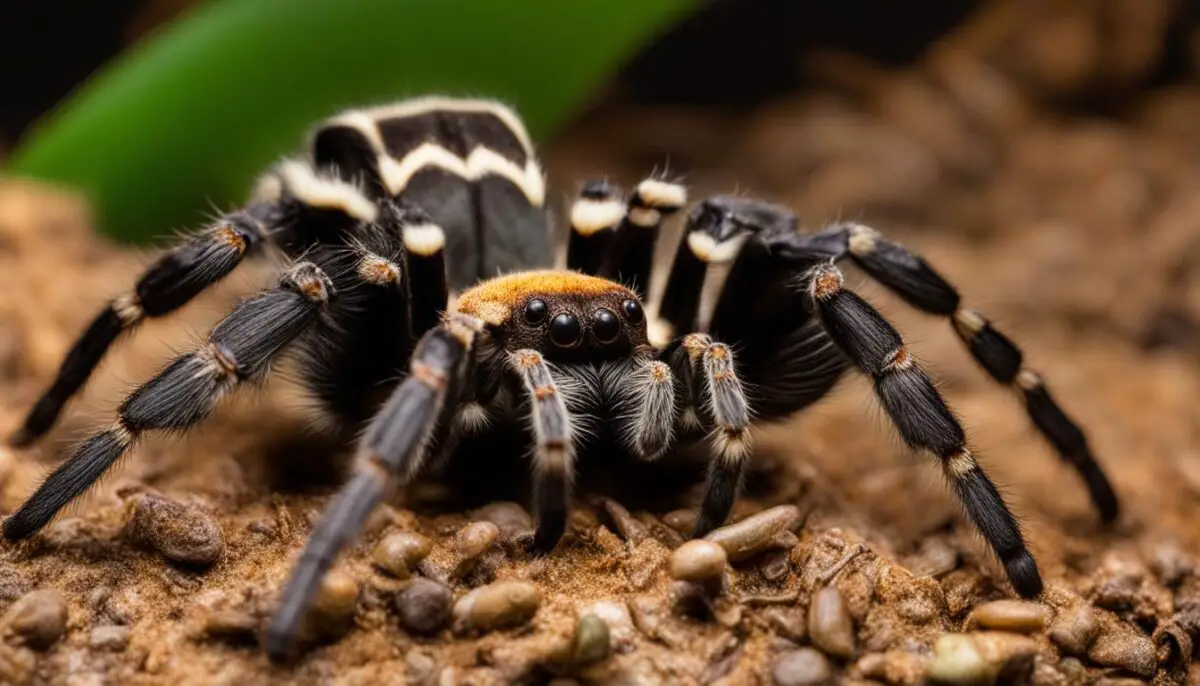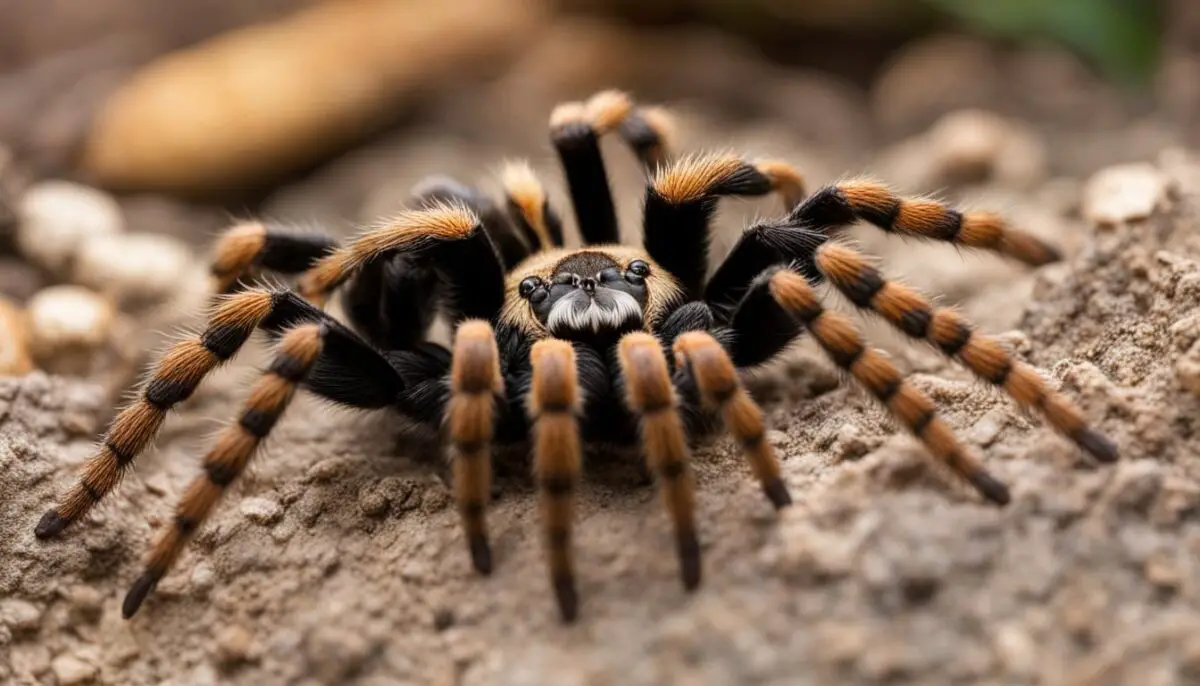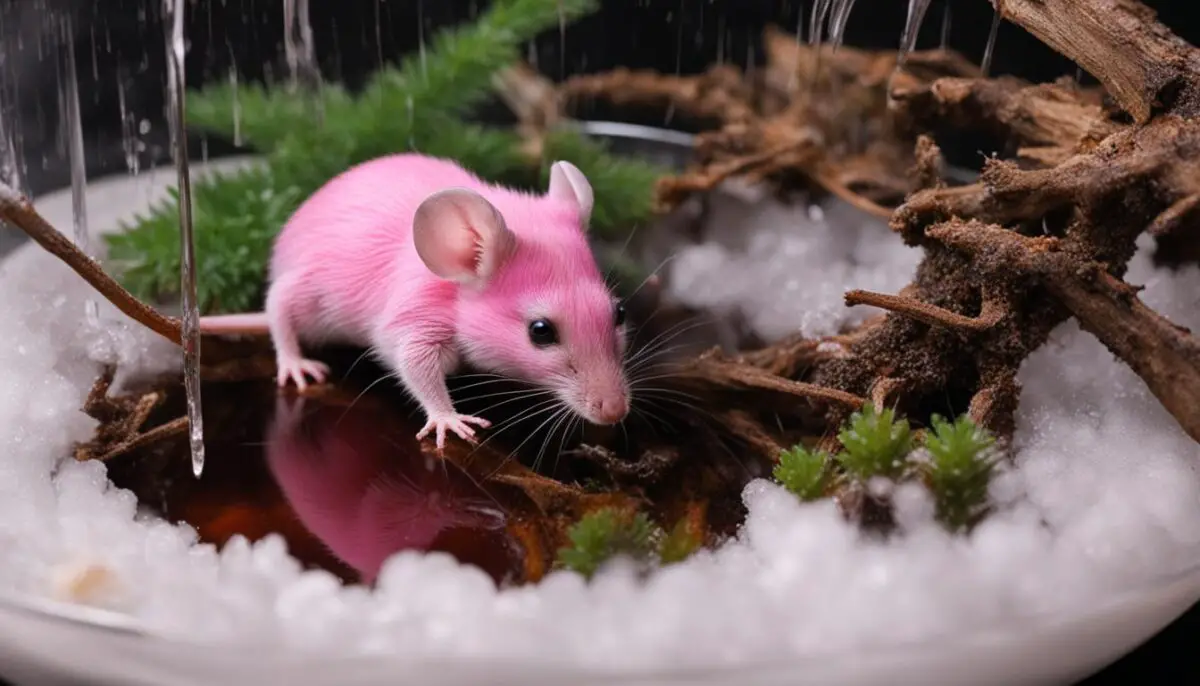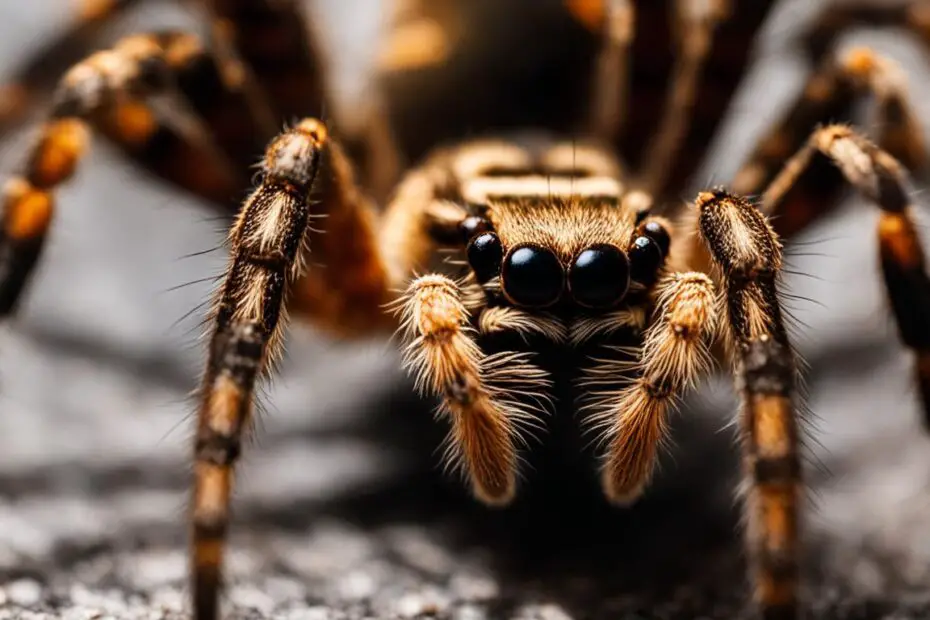Welcome to our article where we explore the intriguing question of whether tarantulas will eat mice. As pet owners, it’s crucial to understand the dietary needs and preferences of these fascinating creatures. Join us as we delve into the tarantula’s diet, feeding habits, and the considerations surrounding feeding them mice.
As natural predators, tarantulas have a diverse diet in the wild, including frogs, lizards, mice, and snakes. However, when it comes to keeping tarantulas as pets, feeding them mice is generally not recommended. While larger tarantula species may enjoy the occasional treat of thawed pinkies (baby mice), there are several reasons why live mice should be avoided.
Key Takeaways:
- Tarantulas in the wild have a varied diet, including frogs, lizards, mice, and snakes.
- Feeding tarantulas live mice is generally not advisable for several reasons.
- Some larger tarantula species, like the Curly Hair Tarantula and Goliath Bird Eater, can eat mice as part of their diet.
- Feeding mice to tarantulas can be dangerous, as mice can injure or even kill tarantulas.
- Feeding live mice to tarantulas is considered cruel and inhumane.
Will Tarantulas Eat Mice
Tarantulas that Can Eat Mice
While feeding mice to tarantulas is generally not recommended, there are certain species of tarantulas that can consume mice as part of their diet. These tarantulas are larger and more aggressive, making them capable of handling larger prey. Here are some of the tarantula species that can eat mice:
Curly Hair Tarantula
The Curly Hair Tarantula (Brachypelma albopilosum) is a popular species among tarantula keepers. They have a calm temperament and can grow quite large, making them capable of consuming mice as part of their diet.
Goliath Bird Eater
The Goliath Bird Eater (Theraphosa blondi) is one of the largest tarantula species in the world. They are known for their ability to consume small vertebrates, including mice. However, it is important to note that Goliath Bird Eaters have specific dietary requirements and should not be fed mice regularly. will tarantulas eat mice
Burgundy Goliath Bird Eater
The Burgundy Goliath Bird Eater (Theraphosa stirmi) is a close relative of the Goliath Bird Eater. They have a similar diet and size, making them capable of eating mice on occasion.
Brazilian Salmon-Pink Bird Eater
The Brazilian Salmon-Pink Bird Eater (Lasiodora parahybana) is a large and colorful tarantula species. They have a diverse diet and can consume small vertebrates, including mice.
King Baboon Spider
The King Baboon Spider (Pelinobius muticus) is a robust and aggressive species that can consume larger prey items. While they are known to eat small vertebrates, including mice, it is important to exercise caution when feeding them.
In conclusion, while there are tarantula species that can eat mice, it is important to consider the specific needs and requirements of each tarantula before introducing mice into their diet. Feeding tarantulas live mice should only be done sparingly and with caution, taking into account the potential risks and ethical concerns associated with this practice. tarantula diet
Dangers of Feeding Mice to Tarantulas
Feeding mice to tarantulas can pose significant dangers to both the spider and the prey. Mice have sharp teeth and claws, making them capable of inflicting injury on tarantulas. A mouse bite can cause harm, ranging from minor wounds to potentially fatal injuries for the spider. Just like with snake owners, it is not recommended to feed live mice to tarantulas due to the risk of injury to the spider. tarantula feeding habits
Mice are known to fight back if they feel threatened or cornered, and this presents a genuine threat to a tarantula’s well-being. The spider may sustain injuries that can lead to infection or even death. As responsible pet owners, it is essential to prioritize the safety of our tarantulas and avoid subjecting them to unnecessary risks.
“Feeding mice to tarantulas can lead to potential injuries for both the spider and the prey.”
Choosing a suitable prey for tarantulas is crucial for their overall health and safety. While mice may be part of a tarantula’s natural diet in the wild, it is important to consider the potential dangers involved when keeping them as pets. Opting for alternative food sources such as gut-loaded insects ensures a safer feeding routine for tarantulas and reduces the risk of harm to both the spider and the prey. tarantula prey
| Common Dangers of Feeding Mice to Tarantulas | Risks |
|---|---|
| Mouse bites | Potential injuries and infections for tarantulas |
| Mice fighting back | Threat to tarantula’s safety |
| Risk of death for tarantula | Severe injuries or infection can be fatal |
Ethical Reasons to Avoid Feeding Mice to Tarantulas
Feeding live mice to tarantulas is considered cruel and inhumane. As pet owners, it is our responsibility to ensure the well-being and ethical treatment of all animals under our care. Feeding tarantulas live mice poses unnecessary harm to both the prey and the predator. do tarantulas eat rodents
Mice can take a long time to die after being bitten by a tarantula, resulting in a slow and agonizing death. This prolonged suffering goes against the principles of responsible pet ownership and the ethical treatment of animals. Opting for a more humane feeding approach by offering insects as prey instead of mice is a better choice for both the tarantula and the prey. tarantula hunting behavior
Choosing to feed tarantulas insects as their primary food source not only reduces the potential suffering of the prey but also eliminates the risk of injury to the tarantula. Mice have sharp teeth and claws, and they can bite, injure, or even kill tarantulas. By avoiding the feeding of live mice, we can minimize the risk of harm to the spider and ensure its well-being.
It is essential to prioritize the ethical treatment of all animals in our care, including both our pets and the prey they consume. By opting for ethical feeding practices, such as offering gut-loaded insects, we can provide our tarantulas with a nutritious diet while promoting responsible and compassionate pet ownership.
| Ethical Reasons to Avoid Feeding Mice to Tarantulas |
|---|
| Feeding live mice to tarantulas is cruel and inhumane. |
| Mice can suffer a slow and agonizing death when bitten by a tarantula. |
| Feeding mice to tarantulas poses the risk of injury to the spider. |
| Offering insects as prey is a more humane alternative. |
Nutritional Needs of Tarantulas
Tarantulas have specific nutritional needs to ensure their overall health and well-being. While in the wild, tarantulas may consume vertebrates like mice as occasional prey, their main diet consists of insects. This is because insects provide the necessary nutrition for tarantulas without the potential risks and ethical concerns associated with feeding them live mice.
When kept as pets, tarantulas can achieve a balanced diet by feeding on gut-loaded crickets and superworms. These insects are rich in nutrients and offer a safe and convenient source of food for tarantulas. They also eliminate the need for handling live mice, reducing the risk of injury to the tarantula and promoting a more humane feeding approach.
Feeding tarantulas a diet primarily consisting of insects helps to ensure they receive the necessary protein, vitamins, and minerals they need to thrive. Insects are a natural part of a tarantula’s diet, and providing them with a varied selection of gut-loaded insects replicates their natural feeding habits.

| Nutrient | Role | Sources |
|---|---|---|
| Protein | Essential for growth and muscle development | Gut-loaded crickets, superworms |
| Vitamins | Support overall health and immune function | Variety of gut-loaded insects |
| Minerals | Aid in various bodily functions and promote strong exoskeleton | Gut-loaded crickets, superworms |
“Feeding tarantulas a diet primarily consisting of insects helps to ensure they receive the necessary protein, vitamins, and minerals they need to thrive.”
It is important to note that not all tarantulas require vertebrates in their diet. While some larger and more aggressive species, such as the Curly Hair Tarantula or the Goliath Bird Eater, may be capable of consuming mice, it is generally not recommended. Tarantulas can thrive and maintain optimal health with an insect-based diet, without the need for vertebrate prey.
By understanding the nutritional needs of tarantulas and providing them with a diet that mimics their natural feeding habits, tarantula owners can ensure the overall well-being of their beloved pets. Opting for a diet of gut-loaded insects reduces the potential risks and ethical concerns associated with feeding live mice and promotes a healthier and more sustainable approach to tarantula nutrition.
Health Risks of Feeding Live Mice
Feeding live mice to tarantulas can pose significant health risks to these arachnids. One of the main concerns is the potential transmission of diseases. Live mice, unlike their frozen counterparts, can carry harmful bacteria and viruses that can make tarantulas ill. It is crucial for the wellbeing of the tarantula to minimize the risk of disease transmission.
Additionally, live mice have sharp teeth and claws and can pose a physical threat to tarantulas. Mice can bite, injure, or even kill tarantulas when cornered or feeling threatened. This can lead to serious injuries or even death for the tarantula.
To ensure the safety and health of tarantulas, it is strongly recommended to opt for the ethical and practical approach of feeding them with other prey options, such as gut-loaded insects. Not only does this minimize the risk of disease transmission and physical harm, but it also provides tarantulas with the necessary nutrition for their wellbeing.
Table: Comparative Analysis of Live Mice and Alternative Prey Options
| Prey Options | Health Risks | Nutritional Value | Ethical Considerations |
|---|---|---|---|
| Live Mice | Potential disease transmission Physical harm to tarantulas |
Moderate nutritional value, but not essential for tarantula health |
Considered cruel and inhumane |
| Gut-Loaded Insects | No risk of disease transmission No physical harm to tarantulas |
Provide essential nutrition for tarantulas Rich in vitamins and minerals |
Ethical feeding choice with minimal suffering for prey |
The table above provides a comparative analysis of live mice and alternative prey options for tarantulas. It highlights the health risks, nutritional value, and ethical considerations associated with each option. Based on this analysis, it is evident that feeding live mice to tarantulas poses unnecessary risks and is not the most ethical choice.
Tarantula Tank Cleanliness and Maintenance
Keeping a clean and well-maintained tank is essential for the health and well-being of your tarantula. Regular tank maintenance helps create a safe and comfortable environment for your pet, reducing the risk of health issues and keeping unpleasant odors at bay. Here are some key considerations when it comes to tarantula tank cleanliness and maintenance:
Regular Spot Cleaning
Spot cleaning involves removing any uneaten prey, molting exoskeletons, or other debris from the tank on a regular basis. Use a pair of tweezers or tongs to gently remove these items, taking care not to disturb the tarantula or its webbing. This helps prevent the growth of bacteria and mold, maintaining a clean and hygienic environment for your pet.
Scheduled Deep Cleaning
In addition to spot cleaning, it’s important to schedule regular deep cleaning sessions for your tarantula’s tank. This involves removing all substrate, decorations, and any other items from the tank and thoroughly cleaning them. Use a mild soap or reptile-safe disinfectant to clean the tank and rinse it thoroughly before adding fresh substrate and reintroducing your tarantula. Deep cleaning should be done every few months or as needed, depending on the size of the tank and the habits of your tarantula.
Monitoring Humidity and Temperature
Tarantulas have specific humidity and temperature requirements that need to be monitored and maintained. Excess moisture or high temperatures can create a breeding ground for bacteria and mold. Use a hygrometer and a thermometer to keep track of the humidity and temperature levels in the tank. Adjust the conditions accordingly to ensure a clean and comfortable environment for your tarantula.

Feeding Guidelines Summary:
- Wait until your tarantula is an adult before introducing mice into its diet.
- Feed a tarantula a mouse at least a week after it molts to allow its fangs to harden.
- Choose an appropriately sized pinky mouse for larger tarantula species.
- Avoid feeding large meals like mice to overweight tarantulas to prevent health issues.
Remember, feeding mice to tarantulas should only be an occasional treat. Gut-loaded insects provide the necessary nutrition for tarantulas and are a more practical and ethical food choice. By following these feeding guidelines, you can ensure the health and well-being of your tarantula while still providing them with a varied and balanced diet.
Choosing the Right Mouse for Tarantula Feeding
When it comes to feeding tarantulas, selecting the appropriate food options is crucial for their health and well-being. While tarantulas can eat mice, it is important to choose the right type of mouse to ensure the safety of your tarantula. In this section, we will explore the various factors to consider when choosing mice for tarantula feeding.
Size Matters
One of the most important considerations when selecting mice for tarantula feeding is the size of the mouse. Tarantulas, especially young and small ones, may not be able to handle larger prey like adult mice. Therefore, it is best to opt for smaller options such as pinky mice. These newborn mice are a few days old, have no fur, and are small enough to be safely consumed by larger tarantula species.
Thawing the Mouse
Before offering a mouse to your tarantula, it is crucial to thaw it properly to prevent any potential harm or fang damage. Thaw the pinky mouse by placing it in a sealable plastic bag and submerging it in warm water for 10 to 15 minutes until it is soft and completely thawed. Avoid refreezing the mouse once it has been thawed, as this can lead to bacterial growth and pose health risks to your tarantula.
Consideration for Fang Damage
Tarantulas have delicate fangs that can be easily damaged, especially when they are in a vulnerable post-molt state. It is advisable to wait at least a week after a tarantula molts before introducing any type of food, including mice. Feeding a tarantula a mouse too soon after molting can result in fang damage, which can be detrimental to their health.
When it comes to feeding tarantulas, it is important to consider their nutritional needs, safety, and ethical concerns. While some tarantula owners choose to offer mice as occasional treats to larger species, it is generally recommended to provide tarantulas with a diet of gut-loaded insects. By selecting the right mice, properly thawing them, and being mindful of fang damage, you can ensure the well-being of your tarantula during feeding time.

Thawing a Pinky Mouse for Tarantulas
Thawing a pinky mouse is a crucial step in preparing it as food for tarantulas. This process ensures that the mouse is safe for consumption and minimizes the risk of potential fang damage. To thaw a pinky mouse, follow these simple steps:
- Take a sealable plastic bag and place the pinky mouse inside.
- Fill a basin or sink with warm water.
- Submerge the sealed bag with the pinky mouse in the warm water.
- Leave the bag in the water for approximately 10 to 15 minutes, or until the mouse is soft and completely thawed.
- Once thawed, remove the pinky mouse from the bag using tongs or tweezers.
- Offer the thawed pinky mouse to the tarantula for feeding.
It is important to note that once a pinky mouse has been thawed, it should not be refrozen. Refreezing the mouse can lead to bacterial growth and potential health risks for the tarantula. Therefore, it is essential to prepare only the amount of food that the tarantula will consume in one feeding.
“Thawing a pinky mouse is a simple and necessary step in preparing it as food for tarantulas. By following the proper method, tarantula owners can ensure the safety of their pets and minimize any potential risks associated with feeding.”

Thawing a pinky mouse is a straightforward process that ensures the mouse is safe and ready to be consumed by a tarantula. By following the steps outlined above, tarantula owners can provide their pets with a properly prepared meal that meets their nutritional needs.
| Pinky Mouse Thawing Method | Steps |
|---|---|
| Thawing Process | 1. Place the pinky mouse in a sealable plastic bag. 2. Submerge the bag in warm water for 10-15 minutes. 3. Remove the thawed mouse from the bag and offer it to the tarantula for feeding. |
| Benefits | – Ensures the mouse is safe for consumption – Minimizes the risk of potential fang damage – Provides a properly prepared meal for the tarantula |
Frequency of Feeding Mice to Tarantulas
Feeding tarantulas mice should not be a regular occurrence. While tarantulas in the wild may occasionally consume vertebrates like mice, their primary diet consists of insects. Therefore, it is best to consider mice as occasional treats for tarantulas rather than a staple part of their feeding schedule.
When offering a mouse to a tarantula, it is important to wait until the spider is an adult. Young tarantulas, especially smaller ones, may not be able to handle such large prey. Feeding a mouse to a tarantula that is too small can result in difficulty or even injury during the feeding process.
Additionally, it is advisable to wait for about a week or two after a tarantula molts before introducing a mouse into their diet. During the molting process, a tarantula’s exoskeleton becomes soft, including their fangs. Feeding a mouse to a tarantula in this vulnerable state can lead to fang damage and potential health issues.
If a tarantula shows no interest in a mouse, it is recommended to stick to gut-loaded insects as the primary food source. This ensures that the tarantula still receives the necessary nutrition for its well-being without the need for live vertebrate prey.
| Feeding Guidelines for Tarantulas |
|---|
| Feed mice as occasional treats, not a regular part of the diet |
| Wait until the tarantula is an adult before introducing mice |
| Allow a week or two after a molt before feeding a mouse |
| Avoid feeding mice to young or small tarantulas |
| Stick to gut-loaded insects if the tarantula shows no interest in mice |
Conclusion
When it comes to feeding tarantulas, the question of whether or not to feed them mice remains a topic of debate among tarantula owners. While some keepers choose to offer pinky mice as a treat to larger tarantula species, there are risks and ethical concerns to consider.
Feeding live mice to tarantulas can pose dangers, such as potential injury to the spider from mouse bites and claws. Additionally, it is considered cruel and inhumane to subject mice to a slow and agonizing death. Opting for a more ethical feeding approach by offering gut-loaded insects as prey is recommended, as it causes less suffering and provides the necessary nutrition for the tarantula’s well-being.
Ultimately, the decision of whether or not to feed a tarantula mice rests with the owner. However, it is important to prioritize the well-being of both the tarantula and the prey when making this choice. By considering the risks, ethical concerns, and the tarantula’s nutritional needs, keepers can make an informed decision that promotes the overall health and welfare of their furry eight-legged friends.
FAQ
Will tarantulas eat mice?
In the wild, tarantulas can have a varied diet, including mice. However, as pets, feeding tarantulas mice is generally considered a bad idea for several reasons.
Which tarantulas can eat mice?
Some tarantulas that can eat mice, including pinkies, are the Curly Hair Tarantula, Goliath Bird Eater, Burgundy Goliath Bird Eater, Brazilian Salmon-Pink Bird Eater, and King Baboon Spider.
Why is it dangerous to feed mice to tarantulas?
Feeding live mice to tarantulas can result in injury to the spider, as mice can bite and injure tarantulas.
What are the ethical reasons to avoid feeding mice to tarantulas?
Feeding live mice to tarantulas is considered cruel and inhumane, as mice can suffer a slow and agonizing death.
What are the nutritional needs of tarantulas?
Tarantulas do not require vertebrates like mice in their diet to be healthy. They can achieve a well-rounded diet by feeding on insects.
What are the health risks of feeding live mice?
Live mice can carry diseases that can make tarantulas ill, posing a risk to their health.
What are the cleanliness and maintenance concerns of feeding mice to tarantulas?
Feeding a large mouse to a tarantula can result in a messy tank, leading to unpleasant smells, breeding grounds for bacteria, and potential health risks.
What are the feeding guidelines for tarantulas?
Young, small tarantulas should not be fed mice. It is best to wait until the tarantula is an adult before introducing mice into their diet.
How do I choose the right mouse for tarantula feeding?
If choosing to feed a tarantula a mouse, it is important to select the right type. Pinky mice, also known as newborn mice, are the most suitable option for tarantulas.
How do I thaw a pinky mouse for tarantulas?
Thawing a pinky mouse for tarantulas is a simple process. The mouse should be placed in a sealable plastic bag and submerged in warm water for 10 to 15 minutes until it is soft and completely thawed.
How often should I feed mice to tarantulas?
Feeding mice to tarantulas should not be a regular occurrence. Mice should be considered as occasional treats.

